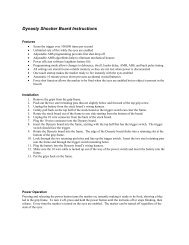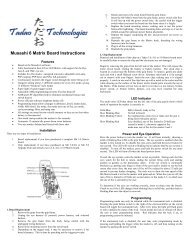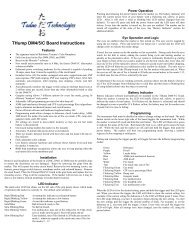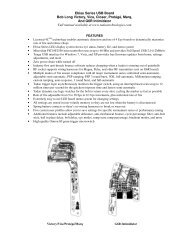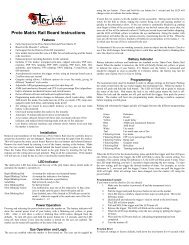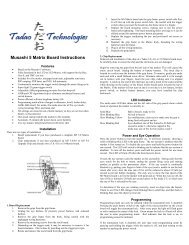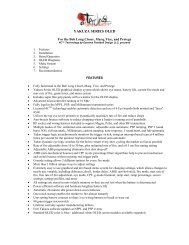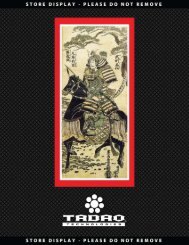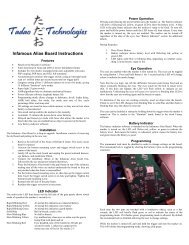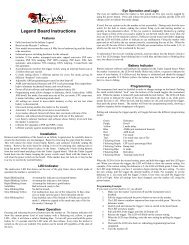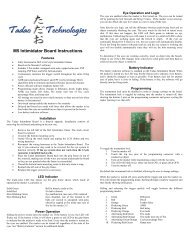Proto Matrix Rail Board Instructions - mcarterbrown.com
Proto Matrix Rail Board Instructions - mcarterbrown.com
Proto Matrix Rail Board Instructions - mcarterbrown.com
You also want an ePaper? Increase the reach of your titles
YUMPU automatically turns print PDFs into web optimized ePapers that Google loves.
in programming mode. The LED will rapidly cycle through every setting color toindicate that the process has <strong>com</strong>pleted.SettingsDebounce – The Tadao <strong>Proto</strong> <strong>Matrix</strong> <strong>Rail</strong> board features an interrupt based debouncealgorithm that effectively “scans” the trigger over 2 million times per second. It runsthis <strong>com</strong>pletely independent of code execution on the microcontroller so your triggerpulls are always registered. The debounce setting is in increments of 1/2 milliseconds.Users should be aware that low debounce settings may cause the marker to read switchbounce as additional pulls, falsely generating shots or near full-automatic fire. Thesetting ranges from 1 to 50 and is defaulted at 10 (5 ms).Dwell – The amount of time the solenoid is energized each time the marker is fired. Thedefault is 25 ms. The range is 5 to 35 ms. Too low of a dwell may lead to inconsistencyor drop-off. Too high of a dwell can cause bad air efficiency.Loader delay – Adds a slight delay after the eye has seen a ball and the bolt is cycled,causing the gun to fire. If not using force fed loaders, it may be necessary to increasethis setting to prevent chopping. A setting of 1 means no loader delay, which is thefastest. The default is 2 and may be set from 1 to 25.AMB (Anti-mechanical bounce) – Allows the user to adjust the anti-mechanicalbounce feature. Mechanical bounce occurs due to the kick generated during each shotand can cause the marker to “run away” on the first few shots. AMB helps stop markersfrom going full-auto when the trigger is pulled very slowly. The default is 2 and may beset from 1 to 5 (1 being off). AMB is only used in fire modes 1 and 2 (semi-automaticunlimited and adjustable).ABS dwell – Amount of dwell time added for an ABS (anti-bolt stick) shot. The rangeis from 1 to 10 additional milliseconds of dwell. The default is 1, which is disabled.ABS programming helps to eliminate first shot drop-off. First shot drop-off occurs whenthe lube and o-rings settle or “stick” inside the marker after it has been sitting. The nextshot fired will be lower in velocity because the bolt has to break free. ABS will slightlyincrease the dwell to <strong>com</strong>pensate if the marker is left sitting for 15 seconds.Fire mode – Included are 12 different fire modes (default is 1):1. Semi-automatic, unlimited rate of fire2. Semi-automatic, adjustable rate of fire3. PSP auto-response4. PSP 50% ramping, adjustable ramp start5. PSP 100% ramping, adjustable ramp start6. PSP burst7. NXL full-automatic8. Auto-response9. 50% ramping10. 100% ramping11. 3 round burst12. Full-automaticSetting 1 is normal semi-automatic with an unlimited rate of fire while the eyes areenabled. When the eyes are turned off, the max rate of fire is set to 20 balls per second.Setting 2 is semi-automatic with an adjustable rate of fire. It limits the maximum ballsper second that can be fired. The cap is set by the max rate of fire setting.Setting 3 is the PSP auto-response fire mode that works as follows:• The first 3 shots of a string are semi-automatic• After the 4th shot the marker will fire on the pull and release in autoresponsemode• If the user stops firing for more than 1 second, the 3-shot semi-automaticcount starts overSetting 4 is the PSP 50% ramping fire mode that works as follows:• The first 3 shots of a string are semi-automatic• After the 4th shot the marker will ramp, adding 1 additional shot for every 2pulled by the user, as long as the user pulls the trigger faster than the rampstart setting• If the user stops firing for more than 1 second, the 3-shot semi-automaticcount starts overSetting 5 is the PSP 100% ramping fire mode that works as follows:• The first 3 shots of a string are semi-automatic• After the 4th shot the marker will ramp up to the loader’s maximum speed orthe maximum rate of fire, as long as the user pulls the trigger faster than theramp start setting• If the user stops firing for more than 1 second, the 3-shot semi-automaticcount starts overSetting 6 is the PSP burst fire mode that works as follows:• The first 3 shots of a string are semi-automatic• After the 4th shot the marker will burst fire 3 shots per pull• If the user stops firing for more than 1 second, the 3-shot semi-automaticcount starts overSetting 7 is the NXL full-automatic fire mode. It functions similarly to the PSP firemodes except, after the 3rd semi-automatic shot, the user may pull and hold the triggerfor the marker to fire in full-automatic.Setting 8 is the normal auto-response fire mode. The marker will fire on each pull andrelease of the trigger, generating 2 shots per full pull cycle.Setting 9 is the normal 50% ramping fire mode. The marker will fire in semi-automaticunless the user pulls the trigger faster than the ramp start setting. Once the ramp startsetting has been achieved, the marker will 50% ramp, adding 1 additional shot for every2 trigger pulls.Setting 10 is the normal 100% ramping fire mode. The marker will fire in semiautomaticunless the user pulls the trigger faster than the ramp start setting. Once theramp start setting has been achieved, the marker will ramp up to the maximum feed rateof the loader or the maximum rate of fire setting, whichever is lower.Setting 11 is the normal 3 round burst fire mode. The marker will burst fire 3 times forevery pull and release of the trigger.Setting 12 is the normal full-automatic fire mode. As long as the trigger is depressed themarker will fire in full-automatic.Fire mode max rate of fire – The max rate of fire setting applies to the 2nd – 12th firemodes. The max rate of fire is adjustable from 14 to 20 balls per second in 1/4 balls persecond increments, and has an unlimited setting for maxing out the loader system. Thedefault is 4, which is roughly 14.75 balls per second. Oscillator inconsistencies fromchip to chip make it impossible to time perfectly, so the only true way to check rate offire is to use a Pact Timer or ballistic chronograph. The red radar chronographs<strong>com</strong>monly found at fields are NOT reliable.Setting BPS Setting BPS Setting BPS1 14.0 9 16.0 17 18.02 14.25 10 16.25 18 18.253 14.5 11 16.5 19 18.54 14.75 12 16.75 20 18.755 15.0 13 17.0 21 19.06 15.25 14 17.25 22 19.257 15.5 15 17.5 23 19.58 15.75 16 17.75 24 19.7525 20.026 Unlimited eyes on20 bps eyes offEye Mode – Four eye modes are available:1. Delayed – If the eye system does not detect a ball in the breech for 1/2 second, themarker automatically fires. This is useful for sound activated loaders because itensures that a shot is fired, even without paint, so the loader will continue to feed.2. Forced with force shot – The marker only fires if paint is seen in the breech or theuser pulls and holds the trigger for 1/2 second, thereby initiating a force shot.3. Test – This mode is specifically for seeing how fast the user can fire the marker, orhow fast the pneumatics can actually cycle. The eyes work to prevent firing ifthey are blocked. This mode is only for dry firing. The LED is used to show thefastest achieved rate of fire:RedYellowGreenBlueWhiteless than 10 bpsbetween 10 and 15 bpsbetween 15 and 20 bpsbetween 20 and 25 bps25 bps or greaterAs long as the user continues to fire, the fastest achieved rate of fire will continueto be displayed on the LED. If the user stops firing for 1 second, the LED willcycle back through the rate of fire colors.
4. Training – This mode works just like the test eye mode, but features an adjustabledwell setting independent of the normal dwell, which makes it easy for users toadjust their trigger settings and try them out with much less noise and airconsumption. The training mode dwell setting corresponds with this eye mode.Note: The test and training eye mode works with any fire mode selected. The fire modemax rate of fire is set to unlimited while in test eye mode.CPF (Cycle percentage filter) – The cycle percentage filter allows adjustment of thepoint within the current firing cycle that a new buffered shot is allowed. Almost allelectronic paintball markers allow a single shot to be buffered in the event the user isfast enough to release the trigger and pull again during the current firing cycle. TheCPF setting is adjustable from 1 to 10. Setting 1 turns the CPF off, allowing bufferedshots at any point in the firing cycle. Setting 2 through 10 sets the percentage of thefiring cycle that must pass before shots may be buffered:1. CPF turned off2. 10% of the firing cycle must pass before a buffered shot is allowed3. 20%4. 30%5. 40%6. 50%7. 60%8. 70%9. 80%10. 90%A higher CPF setting results in less unintentional bounce. For instance, it is possiblethat if your debounce setting is border line, you can fire the marker a few times, thenhold it loosely and allow it to brush against your finger, going full-automatic. Sincemost switch bounce from either a low debounce setting or mechanical bounce occursalmost immediately after the trigger is released, CPF can be very effective in eliminatingfalsely generated trigger activity.Ramp start – This setting is only used for the four ramping fire modes (PSP 50% and100% ramping, and normal 50% and 100% ramping). It sets the minimum pulls persecond that must be maintained for the software to add shots or ramp up to themaximum rate of fire setting. The default is 5 and is adjustable from 4 to 14 pulls persecond.Gangster mode – The Tadao <strong>Proto</strong> <strong>Matrix</strong> <strong>Rail</strong> board includes a special mode that canbe applied 3 different ways to each of the 12 fire modes, giving 36 “breakout” style<strong>com</strong>binations. Gangster mode gives the user full-automatic with an unlimited rate offire for a single pull, for use at the start of the game. The setting is defaulted at 4, whichturns gangster mode off. Settings 1, 2, and 3 dictate at which pull that gangster modewill be<strong>com</strong>e active. If set to 1, the first shot after you turn on the marker will be fullautomaticwith an unlimited rate of fire for as long as you hold down the trigger. Assoon as you release the trigger, the marker will stop shooting and default back to yourselected fire mode. If set to 3, the gangster mode will be active on the third shot afterthe marker is turned on. Regardless of the fire mode selected, the shots before thegangster mode will be semi-automatic. Gangster mode can only be used once for eachtime the marker is turned on.Note: The gangster mode is illegal for use in all tournament series. TadaoTechnologies LLC takes no responsibility for the user’s choice in using thegangster mode.Bolt delay – This setting determines how long the eyes are ignored after the dwell timeends. Some delay is necessary to allow the bolt to get far enough forward so the eyesystem does not mistake a small gap between a paintball and the bolt face for a boltreturn. The default is 10 ms and may be set from 1 to 15 ms. Higher settings will reducethe maximum capable rate of fire, while lower settings may lead to skipped or blankshots because the bolt does not have enough time to block the eyes on its forward stroke.Training mode dwell – This setting selects the markers dwell time if using the trainingeye mode (eye mode set to 4). The dwell time is reduced so that the marker barelycycles, consuming less air and emitting less noise so users can train their finger speed.This setting is adjustable from 1 to 10 ms, and is defaulted at 2 ms. If this setting is toohigh, the marker may actually fire. If that is your intention, you should switch to the testeye mode, which uses the normal dwell setting.Additional FeaturesDraxxus Pulse loader RF transmitter harness – Included with your board is a wiringharness that allows plug and play installation of the Draxxus Pulse loader RFtransmitter. The wiring harness plugs into the solenoid socket, then splices off to thetransmitter and actual solenoid connector. When installed, the transmitter willautomatically be powered during every shot once it is synchronized with the Pulseloader. Alternatively, a separate Pulse socket is located just below the trigger switch.You may use this socket to reduce the amount of extra wiring in your grip frame. If youchoose to use the solenoid socket method, the amount of power applied to thetransmitter is 9 volts. If you use the integrated Pulse socket, the transmitter is given 5volts. Depending on your particular transmitter one or the other may work morereliably, so it is re<strong>com</strong>mended that you test out the synchronization of the Pulse loaderto your transmitter before playing.Force Shot – In the event the eyes are enabled, the breech is empty, and the user wantsto fire a clearing shot, a force shot can be initiated by pulling and holding the trigger for1/2 second. This is useful with force fed loaders that sometimes push a ball slightly intothe detents where the eyes are unable to see it. After force firing, the next ball will load,and operation will continue as normal.A tip for setting the debounce, AMB, and CPF – This only applies to semi-automaticfire modes (modes 1 and 2) since AMB is disabled in the PSP fire modes or NXL mode.Debounce, AMB, CPF setup steps, while using paint and air:1. Turn AMB and CPF off (set both to 1).2. Starting at debounce 1-3, raise the debounce setting a notch at a time untilexcessive trigger bounce goes away. The goal is to have one pull, one shot,regardless of rate of fire. Do NOT slow pull test for bounce during this phase.Instead, pull the trigger rapidly or walk it, listening for double or triple fires.3. When it appears that it is only one shot, one pull for solid trigger pulls, try theslow pull test. Holding the marker steady, slowly pull the trigger and see ifmultiple shots can be generated from the single pull.4. Increase the CPF setting a notch at a time until the slow pull bounce starts todisappear. An additional test is to fire a few rounds quickly, then hold the triggerright on the activation point to see if the marker will run away.5. If you reach setting 10 with CPF and the marker can still be slow pulled to firefull-automatic, your debounce setting is probably too low. Go back to step 2.6. AMB should not be set above 3, if possible, since it is not as transparent to theuser as CPF. Even a CPF setting of 10 will not be noticed by the user.Example Setting Profiles:1. Tournament legal semi-automatic (NPPL)a. Fire mode 1 or 2 (semi-auto unlimited or capped)b. Debounce 5-20c. AMB 2d. CPF 2-5e. Loader delay set to match your loader (1-4 for Halo, 4-10 for gravity feed)2. PSP X-Ball, CFOAa. Fire mode 3, 4, 5, or 6b. Max rate of fire set to 3-5, depending on Pact Timer readings. To be safe,use setting 3 (14.5 balls per second).c. Debounce 5-20d. Ramp start 5 or higher if using PSP 50% or 100% rampinge. Loader delay set to match your loader (1-4 for Halo, 4-10 for gravity feed)3. Millenniuma. Fire mode 4, 5, 9, or 10 (PSP or normal ramping modes)b. Max rate of fire set to 3-5, depending on Pact Timer readings. To be safe,use setting 3 (14.5 balls per second).c. Debounce 5-20d. Ramp start 8 or highere. Loader delay set to match your loader (1-4 for Halo, 4-10 for gravity feed)4. NXLa. Fire mode 7 (NXL full-automatic).b. Max rate of fire set to 3-5, depending on Pact Timer readings. To be safe,use setting 3 (14.5 balls per second).c. Debounce 5-20d. Loader delay set to match your loader (1-4 for Halo, 4-10 for gravity feed)5. Ludicrous Speed (absolute fastest/bounciest)a. Any fire modeb. Max rate of fire set to 26 (unlimited)c. Debounce 1d. AMB 1 if using semi-automatice. CPF 1f. Ramp start 4 if using any ramping modesg. Loader delayAdditional Informationwww.tadaotechnologies.<strong>com</strong>




